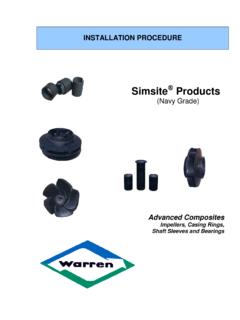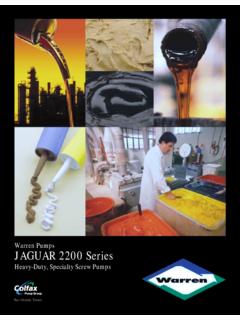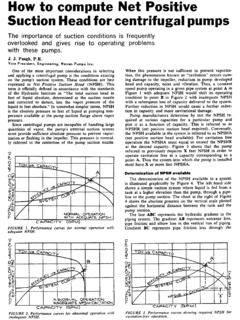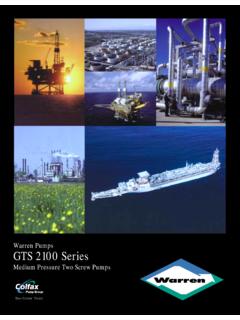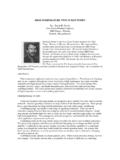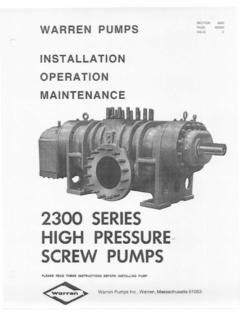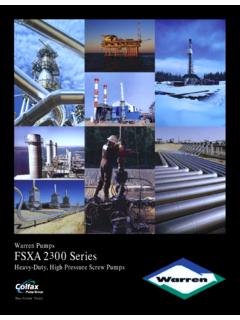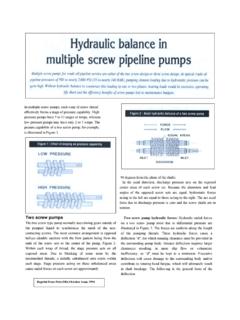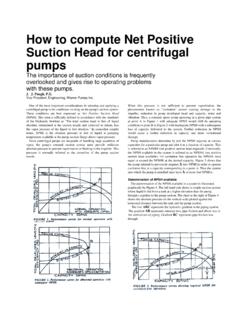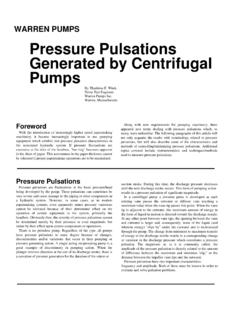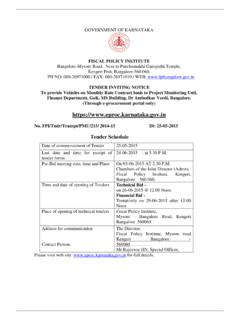Transcription of POSITIVE DISPLACEMENT PUMPS-PERFORMANCE …
1 POSITIVE DISPLACEMENT PUMPS-PERFORMANCE AND APPLICATION. by David B. Parker Manager, R&D Testing Warren pumps Incorporated Warren, Massachusetts from Proceedings of 11th International Pump Users Symposium. Copyright 1994. All rights reserved. Reprinted with permission of the Turbomachinery Laboratory, Department of Mechanical Engineering, Texas A&M University, College Station, Texas 77840-3123. POSITIVE DISPLACEMENT pumps - performance AND APPLICATION. by David B. Parker Manager, R&D Testing Warren pumps Incorporated Division of IMO Industries Warren, Massachusetts PD pumps come in many designs and operating ranges, but they all work on the same principle. An increasing volume is opened to suction, filled, closed, moved to discharge, and displaced. The delivered capacity is nearly constant throughout the discharge pressure range.
2 This constant capacity will intersect a system curve at a defined point, allowing a high degree of system control. POSITIVE DISPLACEMENT PUMP TYPES. The Hydraulic Institute Standards book differentiates PD pumps into rotary and reciprocating pumps . Rotary pumps are defined as being: vane, piston, flexible member, lobe, gear circumferential piston, or screw pumps . In all of the rotary designs, the chamber is created progressively through rotation of the drive shaft. There may be one or more chambers opened per revolution depending on the design. The chambers are sealed off from suction by close clearance between the rotor and the housing, or by close clearance between intermeshing rotors. Rotation of the shaft moves the chamber along the bore or housing towards discharge. The chamber is displaced to discharge by rotation.
3 The release to discharge progresses with rotation as the volume is expelled so that the flow is typically pulsation free. Reciprocating pumps are defined as being; steam, power, or controlled ABSTRACT volume pumps . In all reciprocating pumps , there are check valves on the suction and discharge. Fluid flows through the suction valve and into the The operating principles of POSITIVE DISPLACEMENT (PD) pumps differ chamber as the plunger, piston, or diaphragm recedes. At the end of the from centrifugal pumps . This basic difference is evident in the pump's stroke, the chamber is at its maximum size. The suction valve closes, the response to a system's head/flow curve. Several pump applications are plunger moves forward into the chamber, forcing the fluid out the presented to illustrate the selection process needed to insure pump discharge valve.
4 The flow from each chamber is a pulse flow. If the pump reliability. The performance overlap region, where both pump types has several chambers, they are timed to have sequential pulses to minimize should be considered, is presented with guidelines to evaluate proper the overall pulsation. selection decisions. The data that must be supplied in PD pump specifications are detailed SYSTEM RESPONSE. both in definition of terms and their significance. Many engineering courses devote considerable emphasis to centrifugal pumps and system PD pumps create flow, centrifugal pumps create pressure. In a PD. response but omit POSITIVE DISPLACEMENT discussion. Specifying a POSITIVE pump, flow is created by enclosing a volume at suction, moving it to DISPLACEMENT pump without prior training is a difficult task.
5 Technical discharge, and releasing it. Pressure is created by the system's response to requirements, performance limitations and terminology are presented to flow. If there was no connection at the discharge flange, the flow would assist the person specifying a PD pump. exit the pump at atmospheric pressure. Centrifugal pumps create pressure The PD pump range of operating conditions is presented in several by first imparting velocity to the fluid with the impeller, then converting examples to illustrate problems that can be overcome with a properly the velocity to pressure with the volute. If there was no discharge flange specified pump. Fluids with large gas fractions or high viscosities can not connection, the flow would exit the pump with that developed pressure. be moved with standard centrifugal designs.
6 PD pumps allow a wider The system requirements will determine the type of pump required in range of liquids, slurries and foams to be transported without product most, but not all, cases. If a system calls for a pressurized network of degradation. Understanding where PD pumps can be used may lead to piping with a constant pressure at various flow rates, a centrifugal pump is opportunities to improve processes. the best option. An example of this type of system is municipal water. In this system, a PD pump would be less efficient. INTRODUCTION Oil pipelines normally require a constant flow at various pressures. At a constant flow rate, pipeline pressure will vary with changes in viscosity. POSITIVE DISPLACEMENT (PD) pumps are not well understood by most Pipelines transport different products with different viscosities and users and specifiers.
7 Properly applied, PD pumps offer significant pressures. Product cooling will increase viscosity and pressure. This is of opportunities to improve processes, improve efficiencies, and reduce concern if a pipeline is temporarily shut down then restarted. A centrifugal costs. may not be able to produce a high enough pressure to clear the line. A PD pump will overcome the pressure and restart flow 680F and atmospheric pressure; psia; 200C, Kg/cm2 absolute. fuel delivery systems require a constant fuel flow to control turbines or By specifying the standard volume of gas and specifying the suction boilers. Pressure may vary as nozzles become clogged or erode open, but pressure and temperature, the volume of gas present at the pump suction flow requirement remains constant. PD pumps supply a steady source of can be calculated.
8 This capacity must be added to the liquid capacity in power. Centrifugal pumps would require recirculation to meet order to size the pump for the required liquid flowrate. If suction pressure requirements. is below atmospheric pressure, even small amounts of entrained gas will Process systems frequently involve batch operations where products are expand in volume requiring a larger pump. circulated through reactors as the viscosity changes. Pressure and flow Capacity should be defined for the rated condition. If there is an acceptable requirements are flexible. At the end of the batch, the vessels are pumped range of capacities, the minimum and maximum acceptable should be out. The pump must be able to handle the full range of viscosities as well stated. This allows pump suppliers to offer standard products without as stripping and dry running.
9 Having to modify for specific capacity requirements. Shear sensitive fluids may require PD pumps to avoid the high shearing action of centrifugal impellers. Most PD pumps operate with laminar RATED CONDITIONS. internal flow regimes. Most applications have one rated condition of service. If there are several SPECIFICATION operating points, a full set of rated conditions should be specified per point. Supplying a range for capacity, pressure, and viscosity without The quality and quantity of information on suction conditions will detailing specific points requires pump vendors to offer units capable of determine the ultimate success or failure of any pump installation. The operating under any combination of ranges. This can add considerable cost majority of pump problems, both centrifugal and PD, start at the suction.
10 To a design. There must be a minimum amount of absolute pressure available to supply Bach rated condition requires a value for: capacity, suction pressure, fluid to the pump suction. PD pumps generally require less absolute discharge pressure, NPIPA, temperature, and viscosity. The description of pressure than centrifugal pumps . the fluid should include the type or specification of the fluid, density, Net POSITIVE Inlet Pressure Required (NPIPR), at the pump suction flange, abrasive or corrosive characteristics, gas content, and solids content. If is the rating of total inlet losses within that pump at rated conditions. there are solids present, the amount, size, and hardness should be Units are pressure terms; PSI, Kg/cm2, Bar, KPa. These losses include the specified. fluid friction loss along the internal suction path, the change in elevation Most fluids, including water and oil, are Newtonian fluids.
